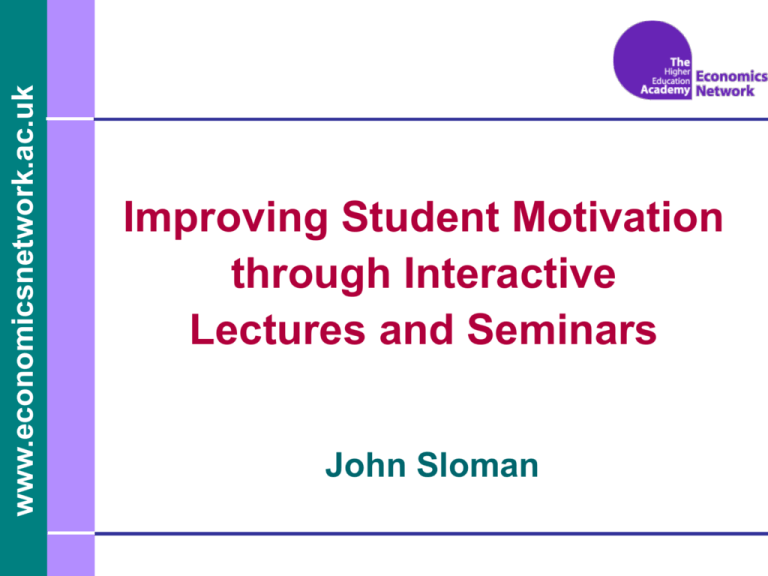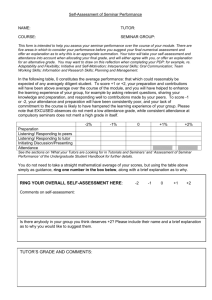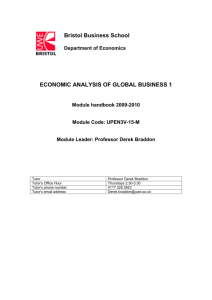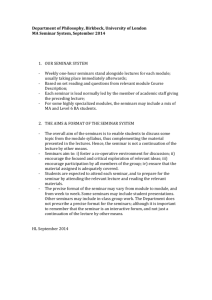
www.economicsnetwork.ac.uk
Improving Student Motivation
through Interactive
Lectures and Seminars
John Sloman
www.economicsnetwork.ac.uk
Tell me and I will forget
Show me and I will remember
Involve me and I will understand
Step back and I will act
(Chinese proverb)
www.economicsnetwork.ac.uk
I've taught
Snoopy to
whistle
I can't
hear him
whistle
I said that I'd
taught him, not that
he'd learned
www.economicsnetwork.ac.uk
Lectures and
Large Workshops
www.economicsnetwork.ac.uk
What makes a good
lecture?
What would make a bad
lecture for your students?
What makes a bad lecture?
•
www.economicsnetwork.ac.uk
What makes a good
lecture?
• Problems with traditional lectures
– Medium for conveying information
– Means of developing student learning
• Focus on student learning
• A lecture exercise!
www.economicsnetwork.ac.uk
Lecturing and student
learning
• Student learning in lectures .
• What are the intended learning outcomes?
• Are popular lectures good lectures?
– Entertaining?
– Spoonfeeding?
• Learning styles
– Visual, aural, conceptual: encourage variety
• Active and passive learning .
• Deep and surface learning
www.economicsnetwork.ac.uk
Lecturing and student
learning
• Surface learning encouraged by
–
–
–
–
–
Heavy workload
Lack of independence
Passive learning
Assessment encouraging recall
Lack of interest
• Deep learning encouraged by
–
–
–
–
–
Active involvement
Relating to experience
Choices
Progressive subject development
Applications
www.economicsnetwork.ac.uk
Student preparation
• Getting background information
– Data
– Case material
• Revisiting previous material
– Start with a test
• Getting students to identify issues
– Use of the VLE
• Assigning prior reading
– Again, start with a test
www.economicsnetwork.ac.uk
Lecture structure
and content
• Clear structure
– Mapping / overview
– Issues to be addressed
• Not too much material .
• Examples
• Mixing presentation with student
activities
www.economicsnetwork.ac.uk
Lecture structure
and content
Lecture session plan
www.economicsnetwork.ac.uk
Activities and breaks
• Do not talk for the whole hour!
– Diminishing returns
• Attention wanes
• Comprehension and learning declines
– Give students things to do that aid their
learning
• Don’t worry about not ‘covering so much’
– Even give them a break
www.economicsnetwork.ac.uk
Activities and breaks
• Activities
– Tests/quizzes (use of PRS?) .
– Brief discussion with neighbour
• e.g. policy implications
• List of advantages / disadvantages
– Doing a calculation / completing a diagram
– Worksheets
• Hybrid between lecture and workshop
• Break
–
–
–
–
Watch video
Compare notes
Tidy up your own notes .
Entertainment
www.economicsnetwork.ac.uk
Building on the lecture
• Note takers
– Post on discussion board
– Use for seminars
• Post questions on discussion board
– Use it as FAQ
– Start debate going with students
• Directly link to seminars/workshops
– Material covered
– Activities in the lecture
• Online study guide: your own or published
– Think of incentives for use
• Preparation for next lecture
www.economicsnetwork.ac.uk
Workshops in Lectures
• Can be used with large lecture groups
• Use worksheets
– Useful for technical and other closed-ended
questions
• Student work through questions in pairs
• Lecturer goes through them at front
• Other considerations
– Layout of room
– Use of GTAs
– Use of audience voting system
www.economicsnetwork.ac.uk
Rethinking the Seminar
www.economicsnetwork.ac.uk
Traditional approaches
to seminars
• Pre-prepared worksheet / problem sets
– Nature
• Pre-set questions
• Students assigned to present answers
• Clarification by tutor as necessary
– Strengths
• Structured study by students
• Can reinforce material in lectures/reading
• Chance to ask questions of tutor
• Chance to evaluate progress
www.economicsnetwork.ac.uk
Traditional approaches
to seminars
• Pre-prepared worksheets / problem sets
(cont.)
– Weaknesses
• Largely passive for students
• Students are poor tutors
• Problem when students have not done the answers:
question of incentives
– Answers?
www.economicsnetwork.ac.uk
Traditional approaches
to seminars
• Giving a paper
– Nature
• Individual (or two), possibly with respondent
• Discussion (with pre-prepared questions?)
• Tutor steered
– Strengths
• Gives students opportunity to present
(key skill)
• Helps develop research skills
• Useful for further work (e.g. essay), helped
by tutor feedback in seminar
www.economicsnetwork.ac.uk
Traditional approaches
to seminars
• Giving a paper (cont.)
– Weaknesses
• Poor learning experience for other students
• Can degenerate into dialogue between
presenter and tutor
• Other students may not prepared for it (being
solely concerned with their own presentation)
• May encourage overspecialisation by student
– Answers?
www.economicsnetwork.ac.uk
Interactive Teaching
• Almost always appeals to students
• Increased involvement = increased
responsibility for learning
• Improves understanding
• Improves motivation
• Often leads to higher pass rates
(lower referral rates)
www.economicsnetwork.ac.uk
The first seminar
• Establishing expectations
– Student expectations of
• Tutor
• Other students
• Themselves
– Informal contract
• Revisit contract in subsequent
seminars
www.economicsnetwork.ac.uk
Seminar activities
• Reporting back on pre-prepared work
• Individual work
– Reading
– Calculations
– Preparing answers to questions
• Working in pairs or threes
–
–
–
–
–
Preparing answers to questions
Clarification of ideas
Comparing and agreeing on answers
Composing essay plans
Marking each other’s work; deciding marking
criteria
www.economicsnetwork.ac.uk
Seminar activities
• Working in fours or fives
– Debating topic and arriving at team view
– Preparing answer for plenary (use flip-chart / OHT)
– Project team with division of labour
• Pyramid
– Bring together small groups which do preliminary
work
• Fishbowl
– ‘Fish’ discuss issue, others observe and note
• Envoys
– Individuals change groups to inject new ideas
www.economicsnetwork.ac.uk
Seminar activities
• Formal debates
– Individuals assigned roles in advance
– Given topic in advance: small groups prepare one
side and then tutor chooses presenters
• ‘Your Witness’ / ‘The Moral Maze’
– Panel to ask questions of pre-assigned witnesses
• Presentation with primed respondents
– One presenter, one respondent, others have to
bring pre-prepared questions
– Two or more presenters (different aspects)
– Group presentations
www.economicsnetwork.ac.uk
Seminar activities
• Role playing
– Pre-allocated roles and scenario
– Pre-reading; roles allocated at time
• Games, simulations and experiments
– Whole class
– In groups
– Single session or over long time period
• Videos
– Followed by quiz, debate or small-group work
• Computer lab sessions (individual or pairs)
• Virtual seminars
www.economicsnetwork.ac.uk
Classroom Experiments
Learning by doing
www.economicsnetwork.ac.uk
Games, experiments
and role playing in PBL
• Strengths
– motivation, involvement, empathy, fun!
– encourages active and deep learning
– illustration and contextualisation
• Potential weaknesses
– over-simplification
– not taken seriously
www.economicsnetwork.ac.uk
Games, experiments
and role playing in PBL
• Overcoming the drawbacks
– clear guidelines
– feedback and reflection
– drawing on concepts in later classes
– linked to seminar activities
• The Exeter FDTL5 project (link)
www.economicsnetwork.ac.uk
Game 1: A trading game
• Students divided into buyers and sellers
• Students given cards
– Black for sellers of the item
• Number on card gives cost of item in £s
• Want to sell above value of card
– Red for buyers of the item
• Number on card gives value of item in £s
• Want to buy below value of card
• Trading takes place
– Individual buyers and sellers agree prices
– Mark their gain on their sheet
– No deal gives no gain or loss
www.economicsnetwork.ac.uk
Game 1: Reflections
• Students get considerable insight into the
working of pit markets
• Equilibrium prices rapidly emerge
– Can vary the cards to see the effects on
equilibrium
• Easy to demonstrate producer and
consumer surplus
• Can discuss information issues
• Can introduce a tax of £x on suppliers
12
Buyers
Sellers
10
Value, cost and price (£)
Value, cost and price (£)
12
8
6
4
2
0
£2 tax imposed
on sellers
10
8
6
4
2
0
1
2
3
4
5
6
7
8
9
0
1
2
No. of trades
(b) Potential gains
3
4
Round
(b) One we tried earlier
An 18 player game
5
www.whystudyeconomics.ac.uk
www.whystudyeconomics.ac.uk
www.economicsnetwork.ac.uk
Game 2:
Expected value game
• TV show: Deal or No Deal?
– Channel 4, six days per week (45 mins)
• US version playable online (link)
– 26 people each with a suitcase of money, the
amount not known to them
• Sums of money vary from 1¢ to $1,000,000
– One contestant us selected to play
• … who eliminates suitcases in batches, whose
contents are then revealed
• After each batch, the contestant is offered a ‘Deal’ by
the ‘Banker’, based on the values yet to be eliminated
• The contestant chooses ‘Deal’ or ‘No Deal’
www.economicsnetwork.ac.uk
Game 2: Reflections
• Virtually all students will be familiar
with the game
• Easy to set up:
– It can be played online
– Or with envelopes and the sums of
money on the whiteboard
• Illustrates decision-making under risk
– Expected value; risk premia; probability;
risk attitudes and what affects them
www.economicsnetwork.ac.uk
Game 3:
Production function game
• Activity
– Production runs (2) in a factory, involving
moving balls from one place to another
– Extra workers are added one at a time
• Equipment:
– About 30 balls (e.g. tennis balls)
– 4 buckets (or baskets or cardboard boxes)
• Students divided into two teams
– Object to get as many balls from one end to the
other in 30 seconds
www.economicsnetwork.ac.uk
Game 3: Reflections
• Easy to set up and fun to play
– Can bring alive a potentially dry subject area
– Flexible: can be played with 1, 2 or more teams
• Can demonstrate
– Diminishing returns
– TP, AP and MP
– Can derive TC, AC, MC, TR, AR, MR and Profit
– Shifts and movements along product and cost
curves from technological change
– Effects of changing fixed and variable costs
www.economicsnetwork.ac.uk
Game 4:
Public goods game
• Aim
– Aim is to make as much money as possible,
irrespective of what others make
• Activity
– Each person (or pair) is given four cards of the
same value (e.g. four threes or four queens)
– Each person plays two cards each round
• Scoring
– Black cards have no value
– Red cards are worth £1 for everyone if played
and £4 just to the individual if not played.
www.economicsnetwork.ac.uk
Game 4: Reflections
• Very easy to set up and fun to play
– Can easily be played in a seminar
– Flexible: can be played with up to 13 individuals
or pairs
• Can demonstrate
– Public goods and external benefits
– Prisoners’ dilemma and Nash equilibrium
– Collusion versus competition
– Motivation and altruism
www.economicsnetwork.ac.uk
Game 5:
Auctioning a pound coin
• Activity
– This is a simple auction of a pound coin
– The only difference is that both the winner and
the next highest bidder have to pay
• At the end
– The money earned can be returned to students
(but don’t tell them this at the start).
– A discussion can then take place about the
issues raised
www.economicsnetwork.ac.uk
Game 5: Reflections
• Simple and flexible
– Simple equipment: a pile of pound coins and a
sheet for recording results
– Can be played in a seminar group
• Can demonstrate
– Sunk costs and marginal costs
– Risk attitudes
– Collusive bidding
– Concepts of equity
www.economicsnetwork.ac.uk
Game 6: A ‘Keynesian
Beauty Contest’
• A game about investor expectations
– predicting share prices based on what you think
other people will do
• Simple to play
– No equipment required other than:
• a calculator for the tutor
• a whiteboard/flipchart for recording results
• The game (each round)
– Students have to select a number from 0 to 100
– A prize is given in each round to the student
who selects a number closest to 2/3 of the mean
www.economicsnetwork.ac.uk
Game 6: A ‘Keynesian
Beauty Contest’
• Each person of N-players is asked to choose a number
from the interval 0 to 100.
• The winner is the person whose choice is closest to p
times the mean of the choices of all players (where p is,
for example, 2/3). The winner gets a fixed prize (e.g.a
chocolate).
• The same game should then be repeated for several
periods. Students are informed of the mean, 2/3 mean
and all choices after each period.
• Students should write down each time (or at the end) a
brief comment about how they came to their choice.
• Time to think in each period: about 3 minutes
www.economicsnetwork.ac.uk
Game 6: Reflections
• Link1 Link 2
• At the end
– Students can be asked to explain their
decisions
• Can demonstrate:
– Expectations formation
– Iterative thinking / progression
– Movement to Nash equilibrium
www.economicsnetwork.ac.uk
Game 7: Tradable
Permits Game
• Six teams
– Each represents a polluting firm
– Each team is given a worksheet and a marginal abatement
cost (MAC) curve
• Each team is given an emissions allocation
– The same for all firms (1480 units)
• Round 1
– Establishes cost of abatement with no trading
• Round 2
– Teams can now trade allocations
– Price is adjusted by tutor until demand equals supply
– Establishes the cost with trading at market clearing price
www.economicsnetwork.ac.uk
Game 7: Reflections
• Uses MC = MR analysis in a different context
• Demonstrates how emissions trading can
achieve any given pollution reduction at
minimum cost
• Flexible: no. of permits can be varied to
demonstrate
– Effect on equilibrium price
– Abatement costs
• Seminar can analyses worksheets of all
teams after the game
www.economicsnetwork.ac.uk
References
• Classroom Expernomics
– http://www.marietta.edu/%7Edelemeeg/games
• Charlie Holt’s Games papers
– http://www.people.virginia.edu/~cah2k/papers.html
• Charlie Holt’s Veconlab
– http://veconlab.econ.virginia.edu/admin.htm
• Charles A. Holt, Markets, Games and Strategic
Behaviour, Pearson/Addison Wesley, 2006
• Bringing Economic Experiments into the
Classroom (FDTL5 project: Univ. of Exeter)
– http://www.economicsnetwork.ac.uk/projects/fdtl5/experiments.htm
Learning
Learning is fundamentally about making and
maintaining connections: biologically through
neural networks; mentally among concepts,
ideas and meanings; and experientially through
interaction between the mind and the
environment, self and other, generality and
context, deliberation and action.
Learning is enhanced by taking place in the
context of a compelling situation that balances
challenges and opportunity, simulating the
brain’s ability to conceptualize quickly and its
capacity and need for contemplation and
reflection upon experiences.
James Eison, Teaching Strategies for the Twenty-first Century, 2002
Active and Passive learning
When students are constrained to the role of
listeners while a lecturer delivers a
monologue, they tend to be passive, not only
at a behavioural level, but on a cognitive level
as well
They do not engage actively in the kinds of
elaborative information processing that helps
to ensure understanding, retention and
transfer
Jessica Ball, ‘Strategies for Promoting Active Learning in Large
Classes’, Journal of teaching Practice, vol 3, 1994
Less is more
Comparing lectures in which 90% v 70% v
50% of the sentences disseminated new
information (with the remaining time in case
being used for restating, highlighting
significance, giving more examples, and
relating to the students’ prior experience) it
was found that students given the lower level
of new content learned and retained the
lecture information better.
Russell, I.J. et al., 1984, ‘Effects of lecture information density on medical
student achievement’, Journal of Medical Education 59: 881-9
Note taking
Evidence suggests that for immediate recall of
a lecture, students who take most notes
themselves come out best and those who rely
on tutor notes come out worst.
In the medium term (a couple of weeks) those
who listened, but took no notes, came out
best.
Longer term, and with the chance for revision,
those who took no notes came out worst, and
those how have tutor notes come out best.
Liz Barnett, LSE, 2003
Audience response system






